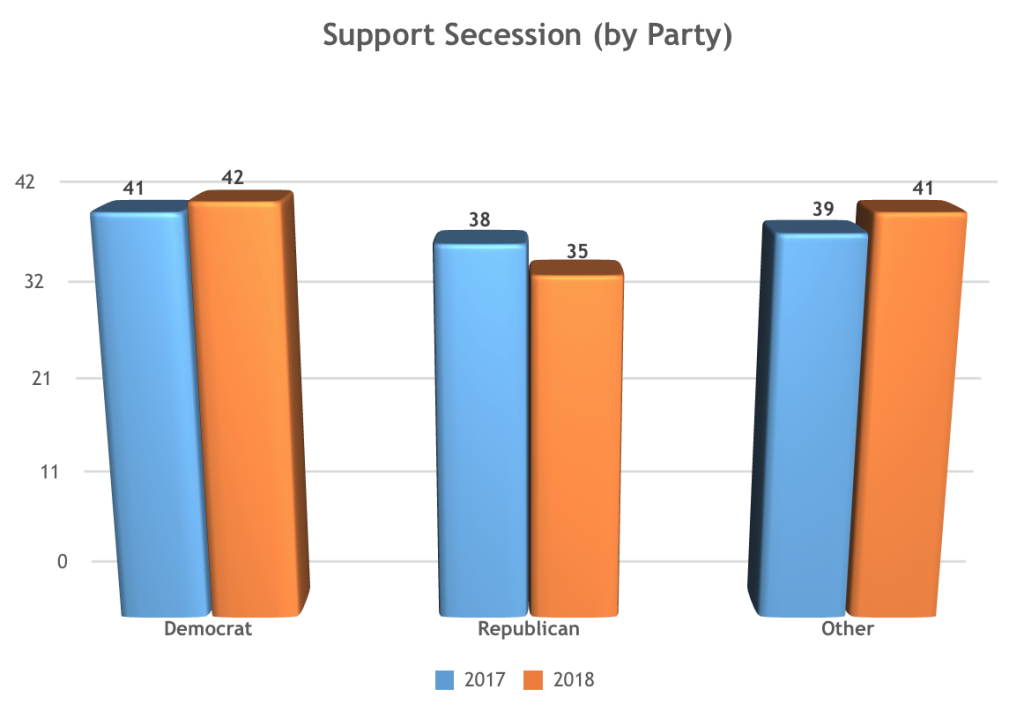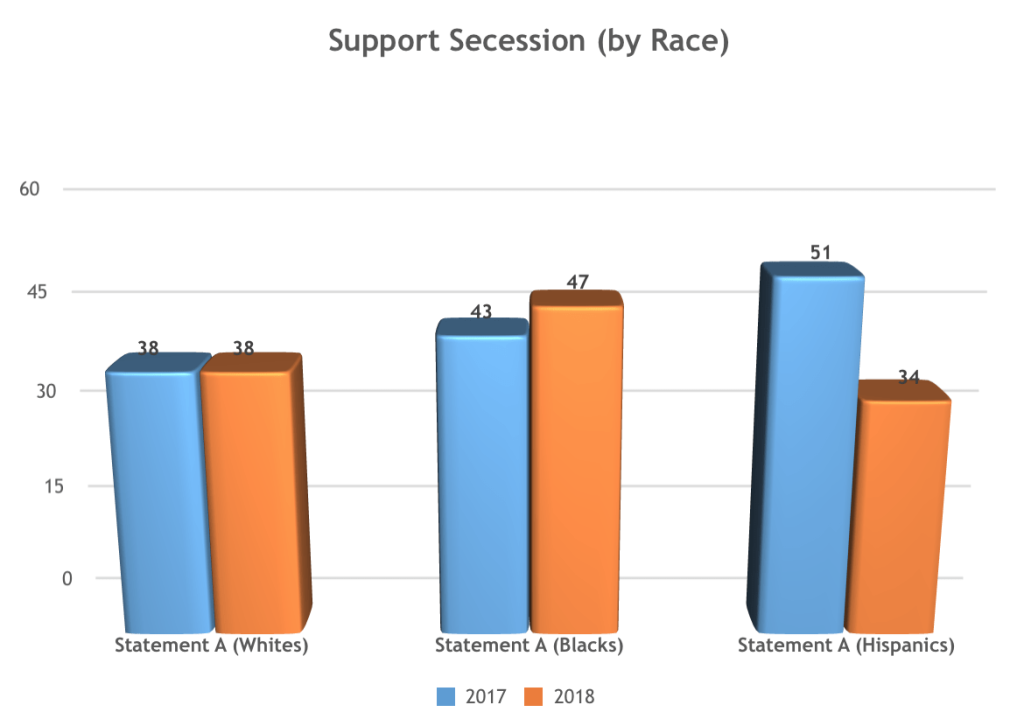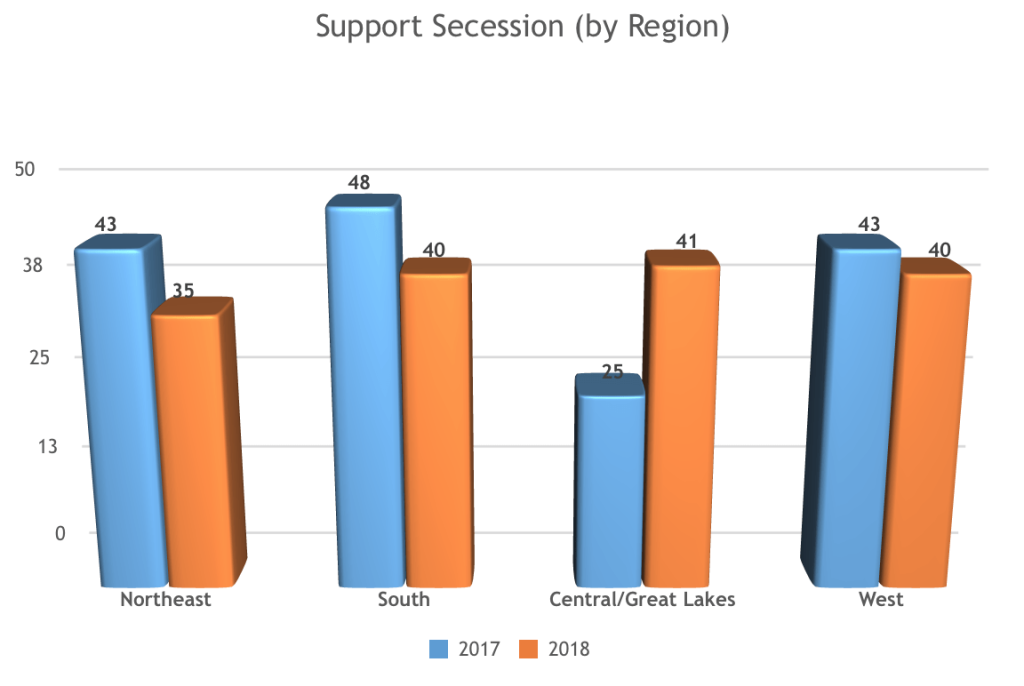by Jeremy Zogby
Amidst the growing intensity and louder calls for independence around the globe, John Zogby Strategies once again conducted a nationwide poll on the topic over the July 4th holiday. We asked 1,001 likely voters the following question:
Which of the following is closer to your view?
Statement A: If a majority of residents within a given state prefer to have the final say over their destiny without the control of Washington D.C., then let them have it – it is their right.
Statement B: If residents within a given state were to take such a drastic measure and secede from the United States, the Federal Government would be justified sending in the military to prevent secession from taking place.
Results still reveal nearly 4 in 10 (39%) agree with statement A and 32% agree with statement B. In other words, a plurality of Americans agree with a state’s right to make a clean break from the Federal Government and go their own way while just shy of one-third (32%) would support a military intervention to suppress a state’s attempt to break away, and 29% are still not sure.
About one year ago we asked the very same question over the 2017 Labor-Day weekend to 800 likely voters in a nationwide survey. Even then, 39% of respondents chose statement A.
Below are charts that compare 2017 and 2018 results from key demographics.



A look at the above charts reveal the biggest movement coming from a drop in Hispanic support for secession (from 51% to 34%). Although not displayed in the charts, those who answered ‘not sure’ among Hispanics increased from 18% to 33%. Whites stayed the same and Black likely voters saw an increase from 43% to 47%.
On the party side, support remained relatively unchanged for Democrats, Republicans, and those identifying as “Other”.
Looking at region, the biggest shifts come from a Southern decrease in support for secession from 48% down to 40% with the Central/Great Lakes region picking up the pace and seeing an increase in support for secession from 25% to 41%.
In the final analysis, while significant changes shifted within a few key subgroups though results remained exactly the same in both 2017 and 2018, overall support for secession remains only 12 points from a majority.
While one could make the case that a nationwide majority support for secession is not likely in the near term due to the appearance of a flat line in the trend – we can infer with relative confidence that still there are a handful of local hotbed areas where majority and even strong majority sentiment exist.
Numerous reports in the news show that states such as California, Texas, and New Hampshire all had referendums on the issue of independence from Washington D.C.
Despite failure of the various State-led independence referendums, the fact remains support for secession has stayed at 39% nationwide from September of 2017 to July 2018. JZS projects the trend will not decrease significantly any time soon.


A nation of red states and a nation of blue states could relate to each other as the USA and Canada do. The USA and Canada don’t care too much who gets elected in the other country. We give each other space.
The USA can split. In my map, only 31% of Democrats would be stuck with Trump as their President. 69% would never have to worry about the Republicans again. The problem of purple states can be solved by allowing counties to secede.
A peaceful, negotiated division of the USA, along with a division of the assets and liabilites of the USA, is definitely possible, would prevent a civil war, and would have many benefits.
The Attorney General of California has approved an effort to gather signatures to put the secession of California on the 2020 ballot. If California secedes, it will provide an example that other states can follow. Those that follow would be likely to federate together according to ideology. The ones left behind would realize they belong with the new federations rather than trying to stay together in the old USA.
The average Trump state voted 57% for a Republican or a Libertarian, and 43% for Hillary or Jill Stein. The Hillary states voted 41%/58%. However, if counties are allowed to split off to join the other country, the Trump states would be 61%/39%, and the Hillary states 39%/60%. If 20% of the opposition party eventually migrated to the other country, the Trump states would be split 68%/31% and the Hillary states 31%/68%. Allowing individual counties to be divided would increase the split to perhaps 69%/31%. The beauty of this is that people who really care about the effects of public policy can move, but no one has to move.
I see splitting the USA as a way to defuse the culture war in a peaceful way. Pew polling has documented the shocking levels of hatred we feel for the other party (see https://www.quora.com/Is-America-irreversibly-divided-Can-we-only-expect-the-divide-to-grow-wider/answer/Chris-Rhodes-65) This is just one of several factors that experts use to predict that the Union of 50 states will not last for another generation
The red states could follow the Constitution as it was written, and the blue states would explore nationalized medicine, national gun prohibition, liberal federal judges, open immigration, etc. But even after splitting, none of the states would be ideologically uniform, so the opposition party could co-opt the moderates and be electable. The Blue state country would become like the UK and Canada (with warmer weather and Latinos), and the red-state country would become like the 1980s USA.
The point is not to get ideological uniformity. The point is to allow people who really care to live in a country that reflects their world view. In the end, 71% of Trump voters and over 69% of Hillary voters would get to see their aspirations realized. Neither camp is happy in the Union because we are always obstructed by the other side from making progress in DC. Even centrists today are not happy because the evenly-matched camps cause gridlock, preventing practical problems from being solved.
Washington DC has been dysfunctional and gridlocked for decades. Democrats don’t want to associate with red-state people that would vote for Trump.
As of March 2017, 44% of Democrats in California are in favor of the secession of California from the USA. If attention to this issue due the California ballot referenda can increase that number above 50%, California could create a precedent for peaceful, orderly secession by referendum or a vote of the state legislature. After the precedent is set, red states such as Alabama could secede and band together with other seceded red states.
No civil war is necessary if seceding states differ from the Confederacy by following 2 simple rules: don’t enslave anyone, and don’t attack Fort Sumter. The EU is not attacking the UK for seceding. The UK gave permission to Scotland to hold a referendum on secession in 2015. Canada allowed Quebec to vote on secession peacefully.
Check out http://www.facebook.com/PeacefulRedStateSecession
Check out http://www.facebook.com/PeacefulBlueStateSecession/